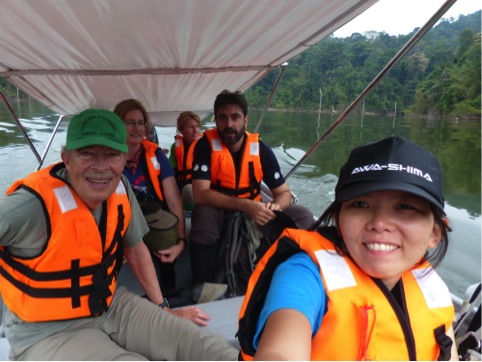Concerning news spread rapidly through social media on Friday 25th of September – more than 30 people, including well known tropical biologist John Terborgh, had been ‘kidnapped’ by a group of local protesters in Manú National Park, Peru.

Field trip to Royal Belum State Park, northern Malaysia. From left to right: John Terborgh, Lisa Davenport, Kim McConkey, Ahimsa Campos-Arceiz, and Lisa Ong. © Reserved.
The abduction took place on the 22nd of September and two days later, John and the other hostages had been released. Apparently there was no harassment nor use of violence and all the hostages are well (except for a person with a dislocated shoulder). John is now (26th September) on his way home, where he will meet his wife before the end of the week.
News of innocent people being retained against their will are always unsettling. In this case, John’s high academic profile and the fact that he is a such a respected and liked member of the ATBC community added a great deal of attention and concern to a story that otherwise might have passed unnoticed internationally.
I found interesting how netizens discussed on the social media whether it was or not appropriate to call the protesters ‘terrorists’. The motivations behind the protest were not clear at the time, but there were suggestions that the local community was ‘fighting against the construction of a road through their lands’. Basically, that they were ‘fighting for conservation’.
Reports coming from Peru now suggest rather the opposite – that the local communities were actually protesting to support the construction of a road that would connect Nuevo Eden with Boca Manu. This road is a project of the regional government that has been stopped due to a complaint from Peru’s National Protected Natural Areas Service (SENANP). SENANP is concerned that the proposed road would lead to illegal deforestation and mining activities inside Manú. Additional reports from the area indicate that the park rangers abandoned their working duties in advance of the protest, to avoid confrontations with the local communities.
Several thoughts come to (my*) mind in the middle of this story. First, local communities are often not the conservation heroes many people like to think they are. It is perfectly understandable for many of these communities to have interest that come in conflict with conservation. That is where proper (sensitive and sensible) policies and regulations come in place.
Second, law enforcement is extremely difficult in contexts where confrontation is culturally and socially very sensitive. This is the case in many remote protected areas. It doesn’t matter how sensitive and sensible policies and laws are, if they cannot be enforced.
And, finally, that we – researchers – are one more of the stakeholder groups involved in conservation and increasingly will find ourselves trapped in conservation conflicts. We cannot afford to claim that we just want to remain neutral while conducting our research. When in the name of conservation we recommend to gazette a protected area or to stop the exploitation of an endangered species, we are crossing our way with the interests of other stakeholders, sometimes large corporations sometimes local communities.
I’m really glad to hear that John is well. When I shared the news of his ‘kidnapping’ with my students, one of them wrote back saying ‘the protesters might have felt they abducted the wrong person. John probably earned the protesters respect during the period chatting with them’. My student has spent time chatting with John in the field, and he obviously earned a great deal of her respect. And mine.
Ahimsa Campos-Arceiz
Kuala Lumpur, 26 Sep 2015
* Note: these are exclusively my views. I’m not representing any organization nor anyone else.



